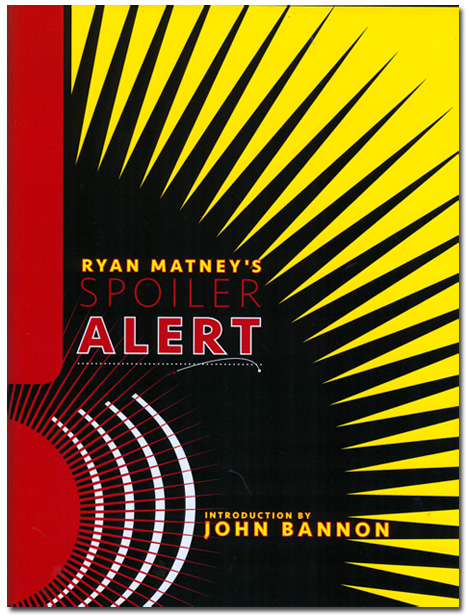|
CHRISTMAS CARDS -- At the Genii convention, Ryan Matney was kind enough to introduce himself. We discussed our respective books, and I certainly looked forward to his Spoiler Alert, a whopping new compendium of material from publisher Ricard Kaufman. I've been slow to the mark. Ryan preceded this title with nine others that eluded me, hence I am blessed (or should I say spoiled?) that he filled his latest with the best of his previous magic along with many new items.
 Magic you can do. Magic you can do.
Given magic's recent publishing schedule, I knew I was banking my Christmas 2017 hopes on this single volume, and I hoped it would be worth that focus. It was. Spoiler Alert is chock full of surprising, entertaining, relatively easy-to-do sleight-of-hand magic along with a few self-workers, a Santa's bag full of seasonal delights.
I frequently mention five or so items that stand out. Impossible this time! Here are five rounded up to a dozen:
The Whitechapel Solution - The George Sands Prime Number Principle (new to me) decides which of four jacks is Jack the Ripper. Lovely patter and effect.
The Columbo Effect - Four queens are lost in the deck. A card is chosen, such as a seven, giving you seven seconds to find the queens. You do. Nice productions!
Hoff-Crosser - Four aces are isolated in half the deck. Spek selects a card from the other half. The halves are spread to reveal an ace (same suit as selection) has migrated to the other half, conveniently next to the selection.
Inner Workings - A card is selected and remembered, two more are chosen and left face down. First selection is lost in the deck. Second two cards are seen and totaled, and magi cuts off exactly that many cards. Last card counted is the selection. Some Paul Cummins, of course, but also nifty use of a Bilis stack (new to me).
Color Strip - Ooh, one of my favorites. Spek and magi shuffle the deck via a new false shuffle called the Share Shuffle. Two speks select cards that are fairly returned. Next, as with a Stripper deck, magi rips the shuffled deck into two halves, red and black. Speks' cards are the only odd-colored cards in each half. Nice setup.
Nepomuk - A lot of magic in this one, maybe too much, but you can edit. Combines Hofzinser Aces with Twisting the Aces (a Fulves version). Of four kings, each that turns over is not the selected suit, until one remains. It finds the selection in the deck. And then it has all been predicted.
The Magic Bullet Theory - Cool! Magi removes a special card (ace of spades, goddess of magic). Spek indicates where to remove three mystery cards from the deck. Now three speks select a card. Under influence of the goddess, all mystery cards turn into the selections, a la Universal Card. Very clean, but in any Everywhere/Nowhere routine, I like to use the Vallarino count as a convincer. It would fit here nicely.
The Walton Deficiency Experiment - From a truly shuffled deck, four consecutive cards are removed. Magi sets one aside, the other three are totaled. Counting down to the total locates the mate to the card set aside. Love this patter line: "The magician says he will attempt to engineer a remarkable coincidence."
Divergence - A die constructed of white cardboard is rolled to determine which of six cards should vanish. It does, and the die is unfolded to reveal that it is the selected card.
Psychic Dyslexia Approximation - Two jokers have the numbers 2 and 3 on their backs. When "23" seems to be the location of a selection in the deck, a countdown proves otherwise. Rearranging the numbers to "32" continues the count, this time with success. Self working.
The Conqueror Worm - My kind of card trick. The queen of hearts is the only innocent ("falsely accused"), and the other three queens are witches. But suddenly the witches morph so that all four cards appear to be the queen of hearts. It is resolved when a ritual to determine good or evil turns the witches into 666.
Amara Rises Again - A card is concealed inside a card box. Is it a king or queen, red or black, club or spade? A ritual determines the answer, then weird writing on the card box morphs into the name of the card. This could have sold as a stand-alone item.
And much more, much relying on little known or used methods from John Bannon, Al Leech, Karl Fulves, Ted Annemann, Stuart Judah, Gordon Bean, and others. A large format hardcover with dust cover, 230 pages, $50 from Kaufman and Company.
| 





